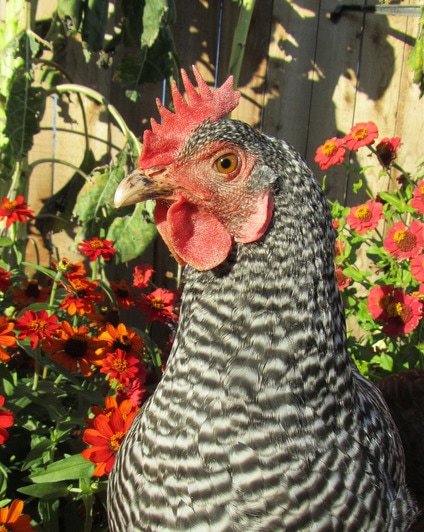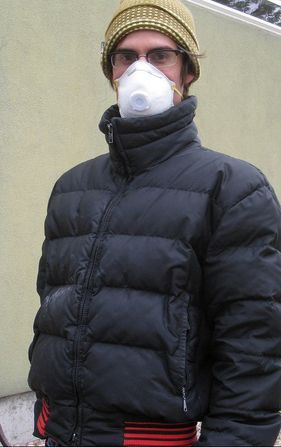CRD-Chronic Respiratory Disease in Chickens-Mycoplasma gallisepticum (MG)
Mycoplasma gallisepticum (MG) is a bacteria-like organism that causes respiratory disease primarily in chickens and turkeys but it can also infect gamebirds, pigeons, ducks, geese, peafowl and wild birds. MG infection in chickens is also known as Chronic Respiratory Disease (CRD, and chickens who are exposed to it will carry the disease for the rest of their lives even if (after treatment) they do not show signs of it anymore. Birds who have been exposed or recovered from MG should not be used as breeding stoc. "MG does not make people sick and eating eggs from infected birds will not hurt you. Do not use eggs from birds that have been treated with antibiotics" (1).
How to tell if your chickens have CRD

Mild Lesions
Coughing
Sneezing
Rales
Difficulty breathing
Foamy eyes
Reduced growth rate
Loss of egg production
MG can be more severe when combined with other diseases such as bronchitis, Newcastle disease, and Ecoli.
"While mortality from MG tends to be low in adult birds, it can be as high as 30% in chickens that are infected with other respiratory viruses or E.coli. Birds that recover may still be infectious (carriers) of MG, and may show no signs of disease until stressed" (See reference 1). See Causes and treatments for CRD below.
Coughing
Sneezing
Rales
Difficulty breathing
Foamy eyes
Reduced growth rate
Loss of egg production
MG can be more severe when combined with other diseases such as bronchitis, Newcastle disease, and Ecoli.
"While mortality from MG tends to be low in adult birds, it can be as high as 30% in chickens that are infected with other respiratory viruses or E.coli. Birds that recover may still be infectious (carriers) of MG, and may show no signs of disease until stressed" (See reference 1). See Causes and treatments for CRD below.
Causes-How Chickens Get MG
MG cannot survive long without a host (your chicken) but can survive long enough to contaminate your entire flock.
High dust content in chicken coop or poultry houses
Infected chickens can give the disease their baby chicks, through eggs
Breeding with and infected mate
Can be spread through body secretions
Can be spread from respiratory secretions (snot) from infected birds in feed, water, and on surfaces
Contaminated feed and water drinkers
Poultry shows, auctions, and swap meets have been associated with MG outbreaks
"MG-infected birds can also spread the disease to clean flocks. People that work with other live birds can also bring back MG to their poultry operations on their person, clothing, footwear and equipment. People can harbor MG inside their noses for days" (1).
High dust content in chicken coop or poultry houses
Infected chickens can give the disease their baby chicks, through eggs
Breeding with and infected mate
Can be spread through body secretions
- Nasal discharges
- Eye discharges
- Fecal matter (chicken poop)
Can be spread from respiratory secretions (snot) from infected birds in feed, water, and on surfaces
Contaminated feed and water drinkers
Poultry shows, auctions, and swap meets have been associated with MG outbreaks
"MG-infected birds can also spread the disease to clean flocks. People that work with other live birds can also bring back MG to their poultry operations on their person, clothing, footwear and equipment. People can harbor MG inside their noses for days" (1).
How to Prevent & Control MG

Start your flock with disease free birds from known MG free flocks
Practice Biosecurity to keep MG out. (Wear shoe coverings, do not allow vehicles on your property, wear clean aprons, face masks, and gloves).
Keep wild birds away from your chickens
Keep rodents (mice, rats, etc.) away from your chickens
If you visit other birds be sure to change your clothing, foot wear, and wear a mask for a few days when going back around your own birds.
Vaccinate show birds and valuable breeder birds annually (once a year) and monthly right before scheduled shows or onset of lay.
Minimize your contact with other flocks.
Serious breeders use Dipping hatching eggs in an antibiotic cold-water bath subsequent MG testing, and strict culling of infected offspring to prevent exposure to MG.
"Be sure to check state regulations if you use a live MG vaccine. Quarantine new additions to the flock or show birds immediately after a show for at least 4 weeks before mixing them with the entire flock" (1). See Treatments below
Practice Biosecurity to keep MG out. (Wear shoe coverings, do not allow vehicles on your property, wear clean aprons, face masks, and gloves).
Keep wild birds away from your chickens
Keep rodents (mice, rats, etc.) away from your chickens
If you visit other birds be sure to change your clothing, foot wear, and wear a mask for a few days when going back around your own birds.
Vaccinate show birds and valuable breeder birds annually (once a year) and monthly right before scheduled shows or onset of lay.
Minimize your contact with other flocks.
Serious breeders use Dipping hatching eggs in an antibiotic cold-water bath subsequent MG testing, and strict culling of infected offspring to prevent exposure to MG.
"Be sure to check state regulations if you use a live MG vaccine. Quarantine new additions to the flock or show birds immediately after a show for at least 4 weeks before mixing them with the entire flock" (1). See Treatments below
Treatment for MG
"Birds that are infected with MG remain carriers of the disease throughout their lives.
Some antibiotics such as Tylosin or tetracyclines, fluoroquinolones (available by prescription through a licensed veterinarian) can reduce clinical symptoms but will not completely eliminate MG. More importantly, some antibiotics cannot be used for birds raised for meat and eggs. Even if birds have been treated with antibiotics, they can still spread MG to other birds. Harvesting (or culling??) meat birds may be better than treating them because treatment can be expensive. Weigh the costs and benefits of maintaining a flock with MG (which may require the continuous use of antibiotics) or depopulating the infected flocks followed by thoroughly cleaning and disinfecting the facilities and equipment and starting fresh with an MG-free flock. Practice strict biosecurity to keep your flock MG-free" (1).
Some antibiotics such as Tylosin or tetracyclines, fluoroquinolones (available by prescription through a licensed veterinarian) can reduce clinical symptoms but will not completely eliminate MG. More importantly, some antibiotics cannot be used for birds raised for meat and eggs. Even if birds have been treated with antibiotics, they can still spread MG to other birds. Harvesting (or culling??) meat birds may be better than treating them because treatment can be expensive. Weigh the costs and benefits of maintaining a flock with MG (which may require the continuous use of antibiotics) or depopulating the infected flocks followed by thoroughly cleaning and disinfecting the facilities and equipment and starting fresh with an MG-free flock. Practice strict biosecurity to keep your flock MG-free" (1).
Treating the Chicken Coop for MG
While your chickens are being treated for MG you should remove all chickens from the coop for one week. Clean and disinfect the chicken coop (preferably with bleach) floors, roosts, walls, ceilings, nest boxes, and any place that the chickens have contact with. Allow several days for the coop to air out before returning your non infected birds or new birds to it.
What to Do If you have High Mortality Rates
Call your local State Department of Agriculture, State Veterinarian's office or diagnostic lab.
all your respective State’s Department of Agriculture State Veterinarian’s office or diagnostic lab. If you have an unusually high level of mortality on your farm, the dead birds or live birds that show the same symptoms, may be submitted for necropsy to a regional MDA Animal Health Diagnostic Laboratory (1).
all your respective State’s Department of Agriculture State Veterinarian’s office or diagnostic lab. If you have an unusually high level of mortality on your farm, the dead birds or live birds that show the same symptoms, may be submitted for necropsy to a regional MDA Animal Health Diagnostic Laboratory (1).
AUREOMYCIN-CRD Treatment Accepted by the FDA for CRD-MG
Chickens need treatment for CRD. Go to AUREOMYCIN
Find OUt More About Respiratory Disease in Chickens
There are many different types of respiratory diseases that chickens can get. Find out more here: Go to Respiratory disease in chickens
See More Chicken Sickness & Disease-Signs, Symptoms & Treatments
We make it easy to diagnose your sick chickens symptoms with our Chicken Sickness Chart that shows the symptoms for ea and treatments.Go to Chicken Sickness & Treatments
References:
- Jonathan Moyle ([email protected]) and Nathaniel Tablante ([email protected]), University of Maryland Extension; Daniel Bautista ([email protected]), University of Delaware; F. Dustan Clark ([email protected]), University of Arkansas Extension. Recognizing and Preventing Mycoplasma gallisepticum (MG) Infection in Poultry. (June 2015). University of Maryland Extension. Solutions in your community. https://extension.umd.edu//sites/extension.umd.edu/files/_docs/programs/poultry/FS-1008%20Recognizing%20and%20Preventing%20Mycoplasma%20gallisepticum%20(MG)%20Infecti....pdf

